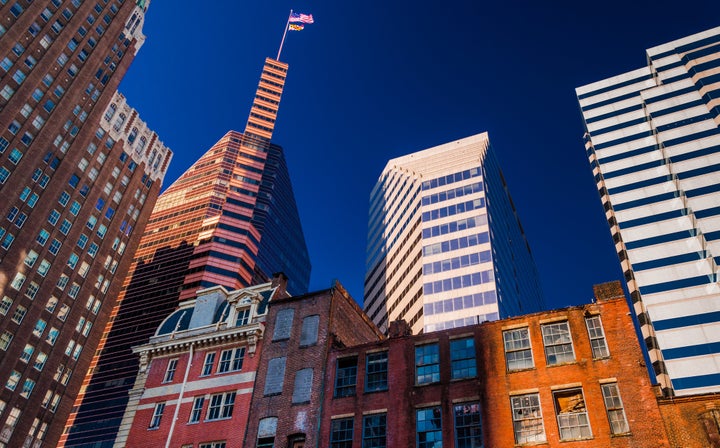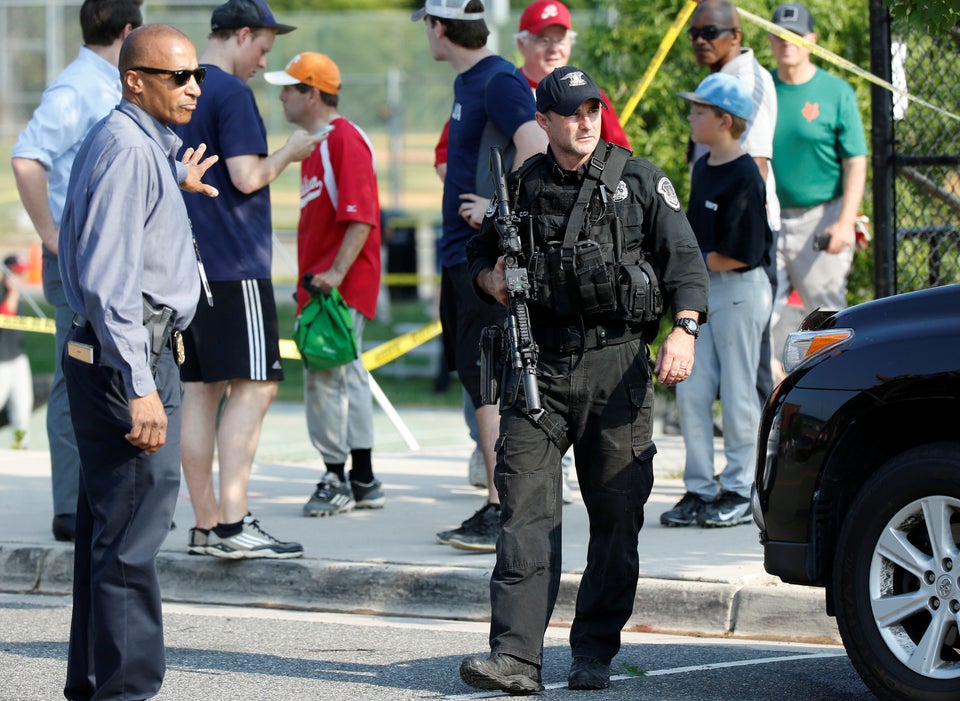Dr. Leana Wen, Baltimore’s health commissioner and an emergency room physician, wrote a moving op-ed last week after a gunman opened fire on a congressional baseball practice. In it, she highlighted the daily horror of gun violence the medical community faces.
Wen has long argued that gun violence is a public health issue ― a medical emergency without a prevention plan.
“Medical professionals are trained to stanch bleeding, stitch wounds and patch up broken bodies,” she wrote in her piece for The New York Times, titled “What Bullets Do To Bodies.” “We are good at our jobs; most gunshot victims survive their wounds. But every day, we are plagued by the question of how to prevent these injuries in the first place, when the damage is so extensive from weapons so readily available.”

Wen spoke to HuffPost on Monday about why she believes gun violence is a public health issue, and what Baltimore is doing to prevent it.
The latest news about House Majority Whip Steve Scalise’s condition is that he has been upgraded from critical to serious, but he was at “imminent risk of death” when he arrived at the hospital. Why was this kind of single gunshot wound so life-threatening?
I don’t want to speculate on the tragic incident involving the congressman. I’ll say that in general what I’ve seen in the ER is that when you have an assault-style rifle or an injury or gunshot wound from an assault-style rifle ― such rifles tend to discharge at much higher velocities than handguns. And depending also on the type of bullet that’s used, it could be a type of bullet that causes fragmentation of the bullet and also causes something called cavitation, which is when it’s not just a single path. It’s not like a knife where there’s a single path of injuries ― there’s significant damage around that entry point as well.
As I talked about in the article, it’s not just the bullet itself that’s the problem ― it’s the injury caused by the bullet. And if the bullet then expands inside the body or if it’s shot at such a high velocity that it ends up damaging other vital organs and blood vessels and other structures, then that damage can be extremely dangerous and the wound can be such that it’s irreparable.
In your piece, you spoke about the aftermaths of gunshot wounds that go unnoticed after the blaring headlines about shootings. Can you elaborate on what happens after, when a patient begins the long road to recovery?
We think about gunshot wounds as death vs. survival, and yes, for my patients, even if they are to survive ― and there is a high rate of survival following gunshot wounds, thankfully, because of our medical advances ― we still have to consider the potential for lifelong consequences.
There could be lifelong consequences of spinal damage resulting in paralysis. I’ve seen many patients go through limb amputations. Because of the nature of the gunshot wound, it could be such that it fragmented their entire bone or because of blood loss. Many patients who have intestinal perforations and other irreparable wounds have to wear colonoscopy bags for a lifetime.
And so many of our patients end up getting addicted to opioid medications because of chronic pain and are also in and out of hospitals for a variety of physical, as well as mental, conditions. These are all the human aspects of survival that we have to consider when looking at the human cost of gunshot wounds.
A HuffPost piece actually ran with the same title as your piece. It focused on Dr. Amy Goldberg, who is the chair of Temple University’s Department of Surgery in Philadelphia. She, too, has spoken out about the horrific aftershocks of gun violence and the shattered lives it leaves behind. Why do you think more medical professionals are chiming into the debate?
There is a hesitation from the medical community to get involved in issues that are potentially politically tinged. Anytime we talk about guns, there is an element of partisanship that unfortunately comes into the conversation, which is part of the reason why I wrote this article. This is not an article with a political bent. This is not an article with a partisan bent.
I wanted to share what it is that we see in the ER, because these are important lessons for everyone to know. It’s important for medical professionals to be aware of it, but it’s also important for people. I hope that individuals who own guns who are potentially at risk for a gun injury will also think about the potential consequences, including these life-changing, life-altering, life-threatening consequences.

What has the response been so far to your piece?
I’ve had a number of people write on all sides of the issue. People have posted a lot of comments on Facebook, Twitter, over email. A lot of people shared that they didn’t know exactly what happens, and that this piece was difficult to read. It was also difficult to write, because I had to relive many of these moments that, frankly, a lot of us would prefer to not think about ― the moments that patients died under our care.
These are the most difficult things that we have to face as physicians ― when patients die under our care despite our best efforts. People have written that they’re glad to read about it and learn about it, despite it being difficult to process.
Other people have commented on the cost implications, too. In our city that’s facing an epidemic of violence, one homicide will cost society at least $1.3 million. For one gunshot wound involving the spine, medical costs alone will be well over $500,000. The total cost of treating gunshot wounds in our city over the last five years is at least $80 million. In addition to the human cost, there are economic and societal costs too.
Of course, there are individuals who do not understand the intention of the Times piece and think that it is making a political statement when it is not intending to, so the responses has been varied as expected.
So many times, we as physicians, nurses and medical health professionals will talk to each other and commiserate with each other about the horrors we’re seeing in the ER, about the horrors we see in our medical practice. By doing that, in a way, we normalize it. We see this as what we encounter in our daily lives, when actually these are not normal things at all.
It is not normal for our patients to have these severe wounds that are inflicted by what I called in the article these “tools of total bodily destruction” ― that’s what these weapons and these bullets are doing. And I wanted to share that with the broader audience to let people know that this is what we see. The devastation and destruction is occurring every day in our communities.
Can you talk about the prevention initiatives you have in place in Baltimore to address gun violence?
We have three strategies that we use to address violence in our city, and specifically gun violence. From our perspective in the Health Department, violence is unequivocally a public health issue. Violence is something that affects people’s health. And it’s a public health issue as it’s similar to a contagious disease in that it spreads from person to person. It can be prevented. It can be stopped. It can be treated.
We use three methods. The first is Safe Streets, which is where we hire individuals from the communities they serve ― many of whom are ex-offenders, previously incarcerated for gang activity and even gun violence. They walk the streets of the city, and they interrupt violence where they see it occurring. They have a relationship and respect from the community. They emphasize the slogan for Safe Streets: “Stop shooting, start living.” They offer alternatives to violence and start changing cultural norms around violence as well.
“Violence is something that affects people’s health. And it’s a public health issue as it’s similar to a contagious disease in that it spreads from person to person.”
- Dr. Leana Wen
Safe Streets has been in our city for about 10 years ― it’s been deemed by a study by Johns Hopkins as one of the most effective public safety strategies. Last year, our Safe Streets employees mediated over 800 conflicts, 80 percent of which were deemed likely or very likely to result in gun violence. The areas that have Safe Streets have seen a 27 percent reduction in shootings, and it’s also changed the norm for our youth .
That’s our first strategy, to stop violence at the time that it’s occurring through these violence disrupters. Our second strategy is recognizing that there is a cycle of violence and trauma that we have to aim to treat mental health conditions, to treat addiction, because these are also underlying what is causing violence.
We have an aggressive overdose prevention program to save lives from drug overdose. We also are increasing our treatment for individuals with a disease of addiction and with mental health disorders. And we have programs to treat trauma as well, to address trauma in our children and to build trauma-informed care in our communities.
The last and third strategy: Because we see violence as a public health issue, we have to go upstream as early as possible. So we see other initiatives like reducing lead in our children and providing glasses to kids also as violence pre-prevention strategies.
And finally, do you believe the Centers For Disease Control and other public health institutions should speak about gun violence as a public health crisis?
Those of us involved in medicine and public health, we are scientists. We should use data and evidence and science when making our decisions. The science is clear that violence is a health issue, that violence is a public health issue. Therefore, we as doctors, scientists and health professionals should be talking about these issues and also should be getting as much information as we can, including through research.
It doesn’t make sense to me that there is a federal ban on research that’s related to gun violence. It doesn’t make sense to me that there are states that have tried to impose gag orders on physicians to even talk to their patients about gun safety as has happened in Florida, among other states.
These are things that we should be even more open to speaking about and engaging with our patients and the broader community about. In the same way that we wouldn’t hesitate to talk to individuals about Ebola, about measles, about heart disease ― those are also health conditions that are affecting our patients and potentially could be taking their lives. Gun violence is such an issue as well.
This interview has been edited for clarity and length.
